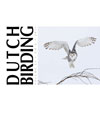Dutch Birding volume 33 (2011) no 6

Eleonora's Falcon at Oostvaardersplassen in September 2011
On 17 September 2011, a group of c 50 birders from Belgium on a day trip to the Netherlands found and photographed a dark-morph Eleonora's Falcon Falco eleonorae at Oostvaardersplassen, Flevoland. The bird frequented an open forest area close to a large wetland area and roosted in dead trees. It was catching dragonflies on several occasions. The bird was watched from c 12:20 to 12:50 and last seen flying in a southerly or south-westerly direction; it was not seen by other observers. The next day, several 10s of birders searched the area, again without success. Based on the photographs, the bird was identified as a second-calendar year, mainly because of the blue-grey cere and orbital ring; the feet were yellow. The plumage was all dark with a brownish tinge. On the breast, a ghost pattern of breast streaking was visible. On the tertials and tail-feathers, dark brown barring was present. The underwing-coverts were black. Size and shape were comparable with a large and long-winged Eurasian Hobby F subbuteo. These characters only fit a second calendar-year Eleonora's and exclude pitfalls like Red-footed Falcon F vespertinus, dark-morph Eurasian Hobby, aberrant Common Kestrel F tinnunculus or Peregrine Falcon F peregrinus, or escaped falcons, including hybrids.
If accepted, this is the first record for the Netherlands. The species is rare in central and north-western Europe, with records in Britain (6), the Czech Republic (1), Denmark (2+), Finland (1), Germany (c 4), Hungary (4), Lithuania (1), Poland (10+), Sweden (16+) and Switzerland (1). Records are concentrated in spring (late April-June) and autumn (August-October), with most in August-September. Dark morph individuals represent c 30% of the whole population and are also rarer as vagrant than pale morph. However, because dark morph birds are probably more easily detected as 'something rare' than pale morph birds, there may be some bias towards dark morph individuals being found as vagrants.
Gilbert Rijmenans, Gelrodeweg 91, 3200 Aarschot, België
(dejille skynet.be)
skynet.be)
Enno B Ebels, Joseph Haydnlaan 4, 3533 AE Utrecht, Nederland
(ebels wxs.nl)
wxs.nl)
terug






